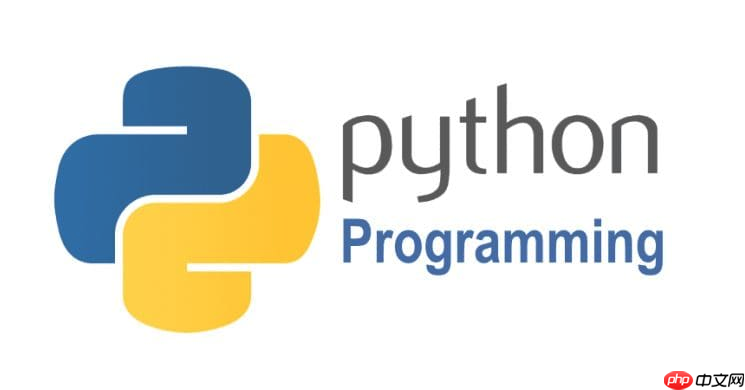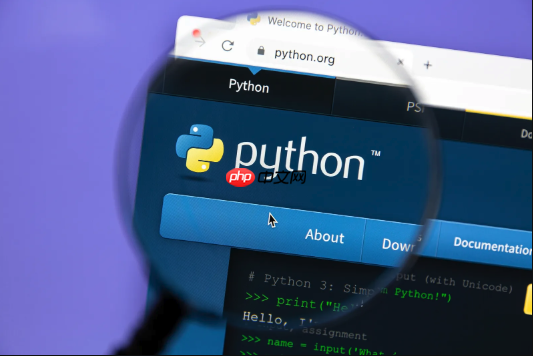在python中实现模板方法模式需定义包含算法骨架的抽象类,并将部分步骤延迟到子类中实现。1. 定义一个抽象基类,其中包含一个模板方法,该方法定义了算法的执行顺序;2. 模板方法调用一些抽象方法,这些方法必须在子类中实现;3. 基类可提供具体方法供子类使用或重写;4. 子类实现变化的步骤,保持算法整体结构不变。例如,abstractclass定义了template_method按照step_one、step_two、step_three顺序执行,其中前两个为抽象方法需子类实现,step_three可被子类重写。模板方法模式的优点是避免代码重复,将公共逻辑放在基类,变化部分交由子类实现,但缺点是增加类数量从而可能提升系统复杂度。

在Python中实现模板方法模式,核心在于定义一个包含算法骨架的抽象类,并将某些步骤延迟到子类中实现。这样既保证了算法的整体结构不变,又允许子类定制特定的实现细节。设计模式在框架设计中扮演着至关重要的角色,它们提供了一套经过验证的、可复用的解决方案,用于解决软件设计中常见的难题,从而提高代码的可维护性、可扩展性和可读性。

解决方案:

模板方法模式的关键在于定义一个抽象基类,其中包含一个模板方法,这个方法定义了算法的执行顺序。模板方法会调用一些抽象方法,这些抽象方法需要在子类中实现。同时,基类也可以提供一些具体的实现方法,供子类直接使用或重写。
立即学习“Python免费学习笔记(深入)”;
from abc import ABC, abstractmethod
class AbstractClass(ABC):
def template_method(self):
self.step_one()
self.step_two()
self.step_three()
@abstractmethod
def step_one(self):
pass
@abstractmethod
def step_two(self):
pass
def step_three(self):
print("默认的步骤三")
class ConcreteClassA(AbstractClass):
def step_one(self):
print("A:步骤一")
def step_two(self):
print("A:步骤二")
class ConcreteClassB(AbstractClass):
def step_one(self):
print("B:步骤一")
def step_two(self):
print("B:步骤二")
a = ConcreteClassA()
a.template_method()
b = ConcreteClassB()
b.template_method()在这个例子中,AbstractClass 定义了模板方法 template_method,它按照 step_one、step_two、step_three 的顺序执行。 step_one 和 step_two 是抽象方法,需要在子类中实现。 step_three 是一个具体的实现,子类可以选择重写它。ConcreteClassA 和 ConcreteClassB 实现了 step_one 和 step_two,提供了不同的行为。

模板方法模式的优点是避免了代码重复,将公共代码放在基类中,将变化的代码放在子类中。缺点是增加了类的数量,可能会使系统更加复杂。
如何在Python框架中使用工厂模式创建对象?
工厂模式是一种创建型设计模式,它提供了一种创建对象的接口,但允许子类决定实例化哪个类。在Python框架中,工厂模式可以用于解耦对象的创建和使用,提高代码的灵活性和可维护性。
class Animal(ABC):
@abstractmethod
def speak(self):
pass
class Dog(Animal):
def speak(self):
return "Woof!"
class Cat(Animal):
def speak(self):
return "Meow!"
class AnimalFactory:
def create_animal(self, animal_type):
if animal_type == "dog":
return Dog()
elif animal_type == "cat":
return Cat()
else:
raise ValueError("Invalid animal type")
factory = AnimalFactory()
dog = factory.create_animal("dog")
print(dog.speak())
cat = factory.create_animal("cat")
print(cat.speak())这段代码展示了一个简单的工厂模式,AnimalFactory 负责创建 Dog 和 Cat 对象。客户端代码只需要指定要创建的对象类型,而不需要知道具体的创建细节。这在框架中非常有用,因为框架可以根据配置或用户输入动态地创建对象。
观察者模式在事件驱动框架中的应用
观察者模式定义了一种一对多的依赖关系,让多个观察者对象同时监听某一个主题对象。当主题对象的状态发生改变时,所有依赖它的观察者都会收到通知并自动更新。在事件驱动框架中,观察者模式可以用于实现事件的发布和订阅机制。
例如,一个GUI框架可以使用观察者模式来处理按钮点击事件。当按钮被点击时,它会通知所有注册的观察者(例如,处理按钮点击事件的回调函数),然后这些观察者会执行相应的操作。
class Subject:
def __init__(self):
self._observers = []
def attach(self, observer):
self._observers.append(observer)
def detach(self, observer):
self._observers.remove(observer)
def notify(self, event):
for observer in self._observers:
observer.update(event)
class Observer(ABC):
@abstractmethod
def update(self, event):
pass
class ConcreteObserverA(Observer):
def update(self, event):
print(f"Observer A received event: {event}")
class ConcreteObserverB(Observer):
def update(self, event):
print(f"Observer B received event: {event}")
subject = Subject()
observer_a = ConcreteObserverA()
observer_b = ConcreteObserverB()
subject.attach(observer_a)
subject.attach(observer_b)
subject.notify("Button Clicked")
subject.detach(observer_a)
subject.notify("Data Changed")这里,Subject 是主题对象,Observer 是观察者接口。当 Subject 的状态改变时,它会调用 notify 方法通知所有注册的 Observer。
策略模式在配置管理中的应用
策略模式定义了一系列的算法,并将每一个算法封装起来,使它们可以互相替换。策略模式让算法独立于使用它的客户而变化。在配置管理中,策略模式可以用于根据不同的环境或需求选择不同的配置加载策略。
例如,一个应用程序可能需要从不同的文件格式(例如,JSON、YAML、XML)加载配置。可以使用策略模式来定义不同的配置加载策略,并根据配置文件类型选择合适的策略。
class ConfigLoaderStrategy(ABC):
@abstractmethod
def load_config(self, file_path):
pass
class JsonConfigLoader(ConfigLoaderStrategy):
def load_config(self, file_path):
import json
with open(file_path, 'r') as f:
return json.load(f)
class YamlConfigLoader(ConfigLoaderStrategy):
def load_config(self, file_path):
import yaml
with open(file_path, 'r') as f:
return yaml.safe_load(f)
class ConfigManager:
def __init__(self, strategy: ConfigLoaderStrategy):
self.strategy = strategy
def load_config(self, file_path):
return self.strategy.load_config(file_path)
# 使用示例
json_loader = JsonConfigLoader()
config_manager = ConfigManager(json_loader)
config = config_manager.load_config("config.json")
print(config)
yaml_loader = YamlConfigLoader()
config_manager.strategy = yaml_loader # 更换策略
config = config_manager.load_config("config.yaml")
print(config)ConfigLoaderStrategy 定义了配置加载策略的接口,JsonConfigLoader 和 YamlConfigLoader 实现了具体的策略。ConfigManager 使用一个 ConfigLoaderStrategy 对象来加载配置,客户端可以根据需要选择不同的策略。
以上就是Python中如何实现模板方法模式 设计模式在框架设计中的应用的详细内容,更多请关注php中文网其它相关文章!

每个人都需要一台速度更快、更稳定的 PC。随着时间的推移,垃圾文件、旧注册表数据和不必要的后台进程会占用资源并降低性能。幸运的是,许多工具可以让 Windows 保持平稳运行。

Copyright 2014-2025 https://www.php.cn/ All Rights Reserved | php.cn | 湘ICP备2023035733号